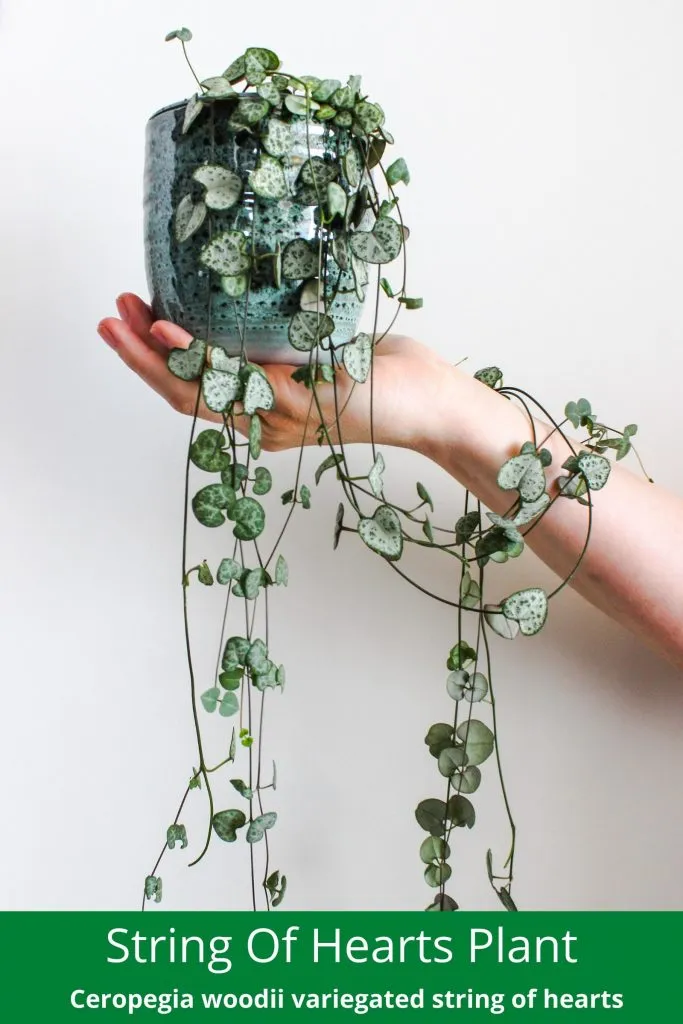
String of Hearts Variegated Plant “Ceropegia Woodii”
The string of hearts or “Ceropegia woodii variegated” plant is indigenous to South Africa. Its heart shaped leaves look beautiful, and the thin vines can reach up to 12 meters when they grow in the most proper circumstances.
This plant is well known by various names, such as rosary vine, sweetheart vine. Botanical name of this plant is Ceropegia woodii. This elegant plant is the most becoming option to append to any living space.
This hanging plant is the most tolerant with direct sunlight succulent; below, you can find some useful resources on how to care and propagate a variegated string of hearts plant.
Quick Look:
⦁ Partial sun to partial shade
⦁ Typical water needs for a succulent
⦁ The plant grows up to 36″ (91 cm) long (trailing)
⦁ Zone 11a (Minimum 40° F | 4.5° C)
⦁ Not cold hardy
⦁ Propagation by stem cuttings, seeds, and tubers
⦁ Generally non-toxic to humans and animals
⦁ Winter Dormant
Available Online Stores
Variegated String of Hearts Care and Propagation Guide
You can easily grow a string of heart plants like other semi-succulent plants. Watering, fertilizer, sunlight, plant movements, Right choices for containers are some primary needs to care for a plant properly. Here we discuss some crucial things to care for a “ceropegia woodii” plant.
Lights and Temperature Needs for Variegated String of Hearts
Variegated String of Hearts plants like glowing bright light and warm temperatures, but they do not bear direct sun for long time. If you want to place them indoors, it would be best to put them into the west or south-facing windows where they get plenty of bright indirect light. Still, if you are placing them into the garden or any outdoor area, partial bright sunlight or shaded sunlight would be ideal for proper growth and flower blooming.

If you wanted to know if your string of hearts plant receives enough light or not for growing well? It is best to observe the gaps among the leaves and the coloring of the leaves. The leaves’ color will be lighter, and the space between them will seem too large; whenever your plant feels a lack of sunlight.
It advised place these house plants under the bright indirect light; if you plan to grow them indoor. The ideal temperature for Ceropegia woodii is between 18 and 24 Celsius so that to prevent sunburn I recommends avoid too much direct sun.
Variegated “String Of Hearts” Plant Water Needs
Just Like other succulents, the String of Hearts plant needs usual watering. Accordingly, provide them a sufficient amount of water whenever the soil dry after each watering.
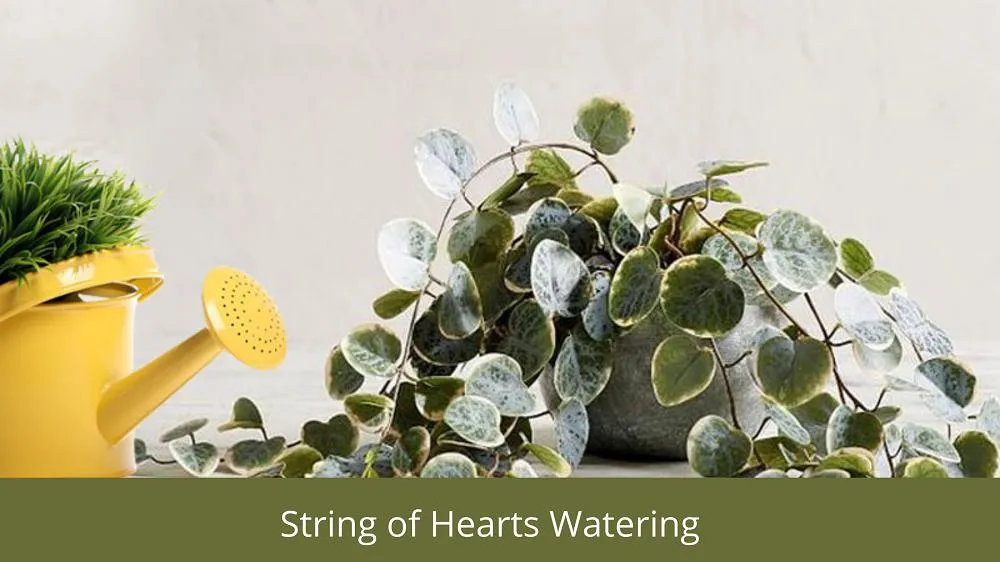
As we know, the String of hearts is a semi-succulent plant, and it’s not like frequent watering, which means these hearts plants store water in their stems for photosynthesis. Overwatering can cause leaf drop; roots may be prone to rot, affecting the overall growth of the plant.
Know more about how to avoid root rot & how often to water succulents
If you left your plant in water or wet soil for a long, then it is the quickest way to kill them off. It is vital to have a drainage hole in the pot or hanging basket. The String of hearts requires less watering on the winter days.
Variegated String of Hearts Plant Size and Growth
The vines of the string of hearts plants can reach around 12 meters long when it gets the right environment to thrive. Although it’s true when you grow them as an indoor house plant, its vines are usually grown approximately 2 to 3 meters long. I potted my string of hearts plant in the garden/outdoor, and its vines reach around 4 meters long.
When your plant gets enough growing conditions like properly filtered lights, well-moisten level, a good amount of warm atmosphere, then it thrives ideally.
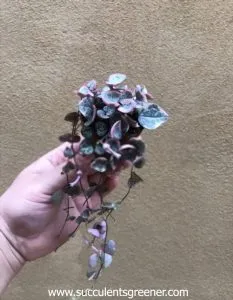
Which Is Best Soil Mix for String Of Hearts Variegata Plant?
A Carty Hottman organic cactus mix is best for a string of hearts plant, but if you want to make your potting mix, it’s also fine. Remember to avoid adding too much nutrition; if you use any ordinary soil mixture, you will need to add some things like perlite or pumice to improving the water drainage efficiency. Coco coir is another good option; you can also combine this with current potting soil.
Read related blog: Best succulent soil
Where To Plant Variegata String of Hearts
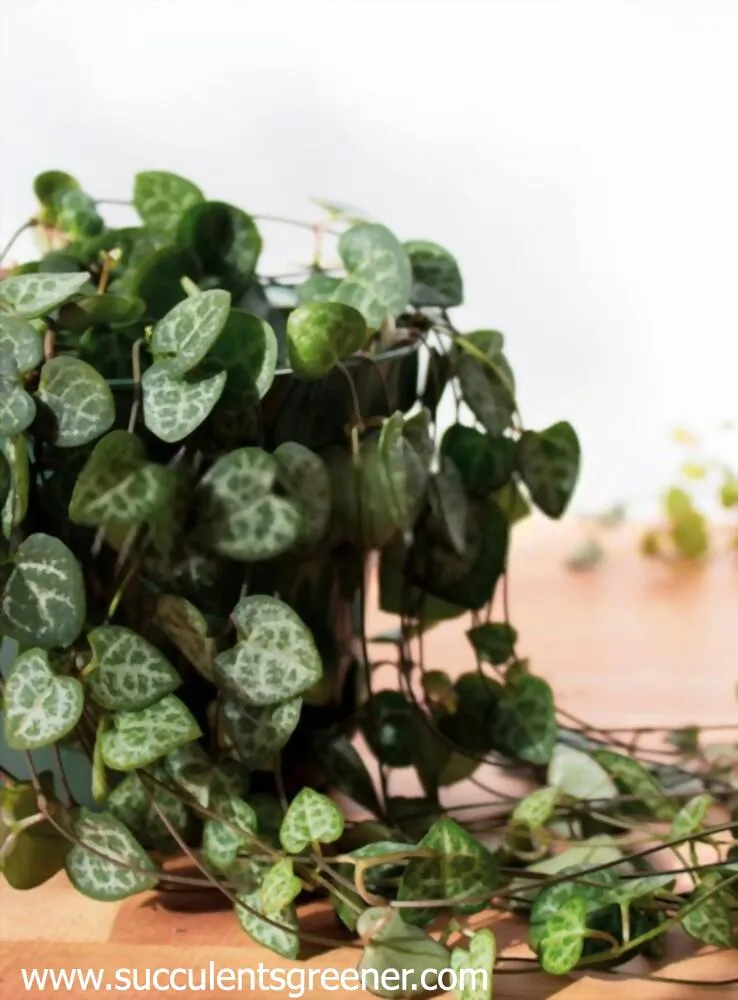
It depends on you where you want to plant your “ceropegia woodii.” It also depends on the atmosphere where you live—generally, Variegata “String of Hearts plants not so much tolerant with the cold environment. If you live in an area where the temperature down up 4.5° C (40° F) then, planting rosary vine in a container would be best; it is because whenever temperatures are dropping, you could move your plant indoors readily.
At indoor, in any room, could you place them? Yes, find a spot where plenty of full to partial sunshine came. Probably north and south-facing windows would be best.
If you plant them in the garden, ensure that they receive 4 to 5 hours of sunlight a day. The leaves of the “string of hearts” plant will appear as a darker color when they receive plenty of sunshine.
Which Is the Best Time to Fertilize the Variegated String of Hearts?
The best to fertilize your “variegata string of chain” plants would be the spring season. Usually, I put some compost on my plants, but you can also use any houseplant fertilizer between growing season March to September, not every month but a 2-month gap is enough for fertilization. You don’t need to fertilize in the wintertime because, in winter, your plant becomes dormant.
Top 3 Propagation Method
Propagating string of heart plants is not easy even some time a failed to propagating new plant. propagating string of heart plant from mother plant to several new growing string
String Of Hearts Through Water Propagation Method:
The string of hearts plants easy to propagate through the water, the roots easily rooting in water. All you need to do just take a few inches-long stem cuttings and put them into the water.
The stem cuttings that are drowning under the water must have no leaves; you need to remove the leaves from the part of the cutting which will be underwater in your container of any glass or vase. In that way, your leaves far from rotting and also your water will be fresh.
Ensure that every stem cutting has some leaves except the underwater part. The roots grow from the part of the stem from which you had removed the leaves earlier, which is underwater. Two or three nodes should be in the water, if not, at least one is necessary.
I bought the well-grown string of hearts plant, and use its stem cuttings for propagation. Genuinely, it’s not the first time I propagate variegated String of Hearts.
Keep eyes on the stem cuttings, if you see that the water getting dirty and murky, ensure to change the water.
It would be best to place your vase or glass in the most appropriate area, where underwater stem cuttings receive enough amount of filtered or partial shade sunlight.
It depends on the warm temperature; enough amount of heat encourages quick rooting of stem cuttings.
Soon you see roots are growing on the tiny tuber from this stem cutting. Later we will talk about tubers. Once your stem cuttings take roots; you can plant them in any pot with appropriate soil. 1/2 inches long roots are enough for planting.
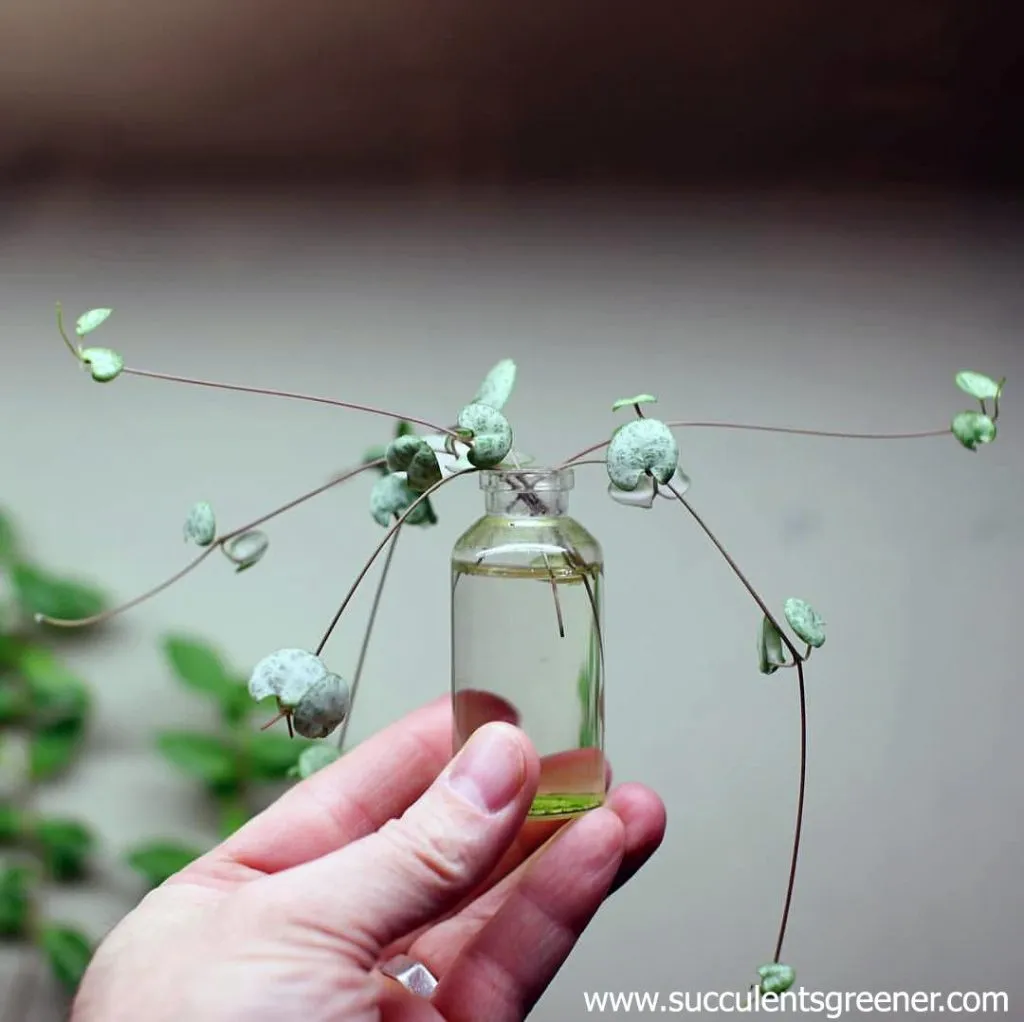
Propagate String of Hearts through Soil Propagation Method:
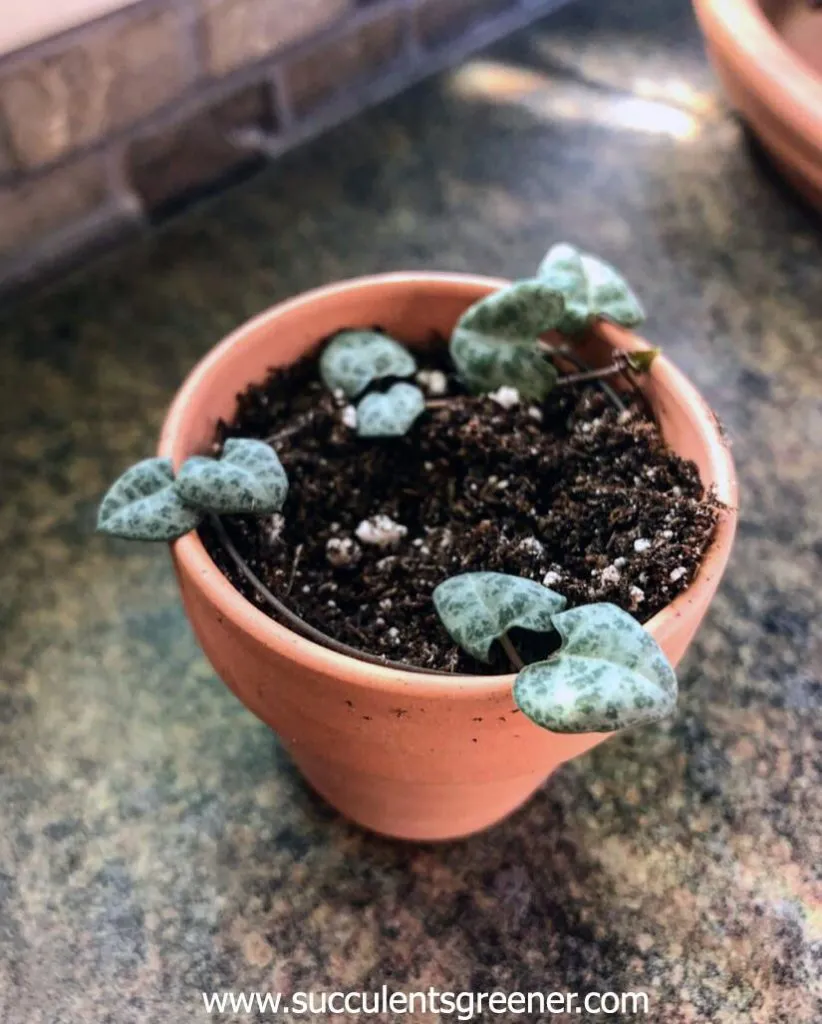
Propagation through Soil is not much different from water propagation. All the starting processes are the same except drowning the stem cuttings in water; you have to stick the cuttings directly in the Soil. Another option for improving the possibility of the root by cuttings, using a rooting hormone, in which you can dip each node that is going under the Soil.
You can buy this rooting hormone from Amazon. Use any nutritious soil mixture and wait. Water the newly potted cuttings; try to keep the Soil hardly moist to increase the overall growth.
Propagating Using Tuber Propagation Method:
It would be best if you got a big tuber for propagation. A fingernail-sized tuber is the right choice for propagating. It would be best if you left some of the tubers on the creeper; gently press it into the soil mixture to grow a root.
You can directly cut the vine from the main “string of hearts” plant whenever roots grow on it.
Alternatively, you also have another option for growing the roots from the tuber. Cut off the vines, including tubers from the main “rosary vine” plant, put them into any container with some soil, cover the tubers with some soil.
Keep them into some bright sunshine and water them so the soil will not dry; watering them once a week; after a few weeks, you will see tuber rooting.
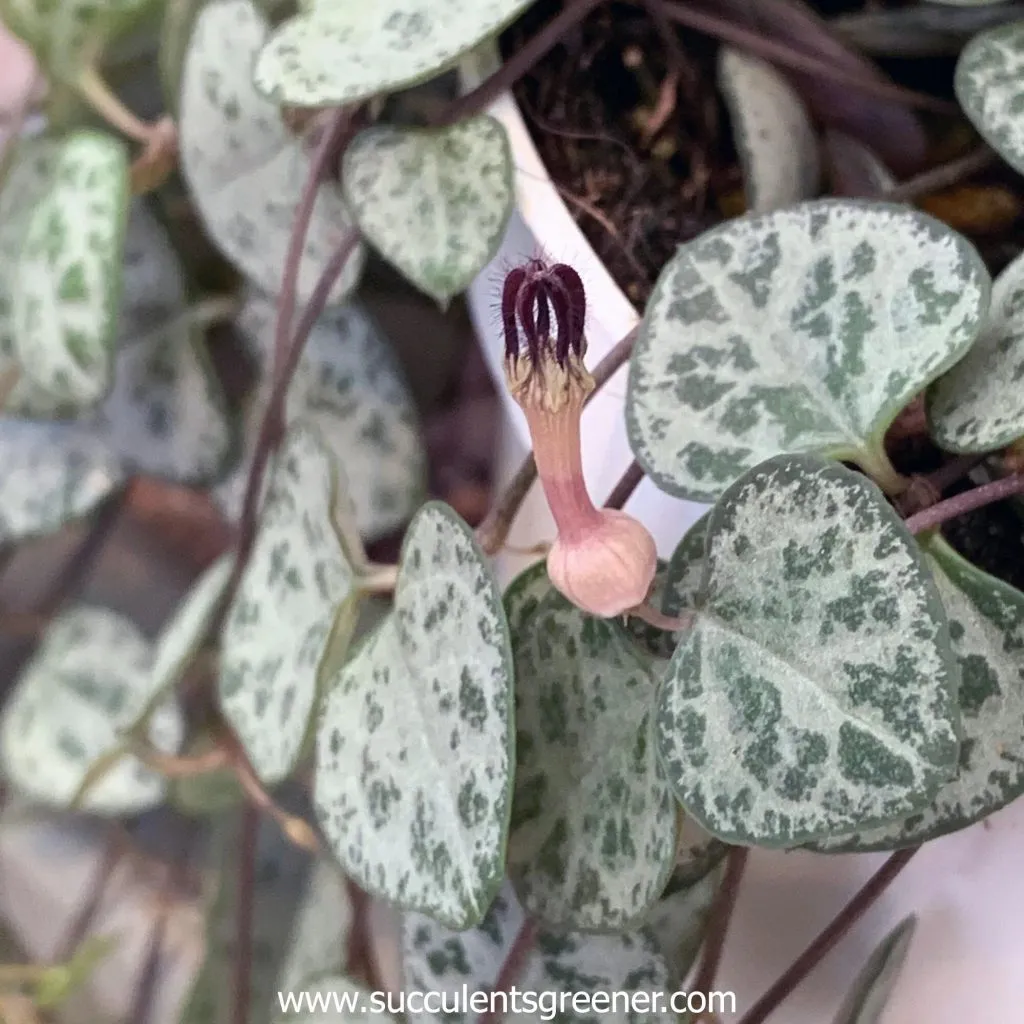
Final Thoughts
The string of hearts or Variegated “String of Hearts” plant has some minor differences: its leaves’ colors. This plant is a perennial succulent vine, where many heart-shape leaves grow on the long stems of the clambering plant.
The “string of hearts” plant has dark green marbled leaves, where the Ceropegia woodii variegata string of hearts has green and white leaves alongside pink and purplish color at the edges, and the purplish tone darker in leaves backside.
All the care and propagation are similar for both. Usually, these plants look attractive when they plant in a table pot or any hanging basket. A hanging basket is trendy and looks gorgeous when hanging at the doorway.
I hope you liked the above details. If you find some other information on a string of hearts plant, you can share through comments without hesitation.
Frequently Asked Questions for String of Hearts Plant
If your problem with the string of hearts plant is not listed here, you can also leave a comment with your question. I will try to answer it asap. Let’s talk about the common concerns for the “Ceropegia Woodii variegated string of hearts” plant.
Can Flowers Bloom on the “String of Hearts Plant”?
Yes! The flowers are bloom on the “rosary vine” plant. Even flowers also bloom on the indoor plant; only if when they get a proper growing environment.
How Can We Prune a String of Hearts Plant Easily?
Prune any String of hearts plant is very easy; whenever you see your plant getting long vines on its space, just cut off the vines accordingly. You can propagate the leftover cut-off vines, do not throw them; put them back into the soil so that they root again.
When To Repot “String of Hearts Plant”?
If the pot in which you potted your String of hearts plant does not have any additional space for plant roots or the plant roots are getting out from the pot sides and pot drainage hole. So then, it is an indication to repot the plant in a slightly big pot.
Which Is the Best Place Buy a String of Hearts Plant?
A “String of hearts plant” or “Variegated String of Hearts plant” are unusual succulent plants and probably will not available at every local plant store, even nurseries too. But you can buy these plants at online stores from some good seller such as Etsy or Amazon. They always have some unique plants in their inventory.

